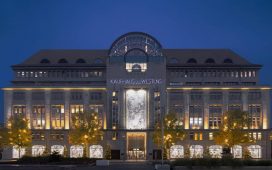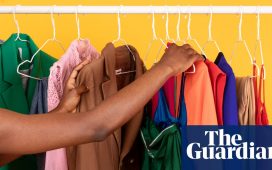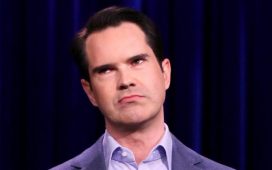There are several thoughts that flash through your mind before meeting a member of a royal family. First of all, should you bow or curtsy upon entering their quarters? While engaged in conversation, how should you address said royal? And then, as you depart, do you reverse like a rabbit from a warren without turning your back, risking sending their collection of Ru ware tumbling to the ground?
Beyond addressing Sheikha Al-Mayassa as “Your Excellency”, no such protocol exists when meeting the Qatari royal. “Nice to meet you,” she says casually, offering her right hand when we arrive at her office in the National Museum of Qatar (NMoQ) in Doha a few hours ahead of the opening ceremony, attended by movie stars (Johnny Depp, Luke Evans), designers (Valentino’s Pierpaolo Piccioli, Miuccia Prada), models (Naomi Campbell, Natalia Vodianova), and the former President and First Lady of France, Nicolas Sarkozy and Carla Bruni, among others.
Behind the Sheikha, as one might expect from the capital of the wealthiest country on earth, is a city panorama so futuristic it could be the imaginings of Luc Besson. “When I come back and forth, I see major changes happening. The speed and the rate of development is so fast,” says the 36-year-old, who spends the majority of her time at her home in New York.

As the chairperson of the Qatar Museums Authority, the Sheikha – who is the sister of the current Emir of Qatar, His Highness Sheikh Tamim bin Hamad Al Thani – is spearheading the oil-rich country’s efforts to become a centre for arts and culture in the Middle East and beyond. Widely regarded as one of the most powerful people in the art world, with an estimated annual spend of $1 billion on art, rumour has it the Sheikha has been behind the record-breaking acquisitions of Gauguin’s When Will You Marry? (reported at $210 million in 2015) and before that, in 2012, a painting from Cézanne’s series The Card Players, which is thought to have gone for $250 million.
But it’s not just her buying power that has sealed her reputation. In the past ten years alone, alongside establishing the NMoQ, she has brought major exhibitions to Qatar, including the double blockbuster Picasso-Giacometti and a collection of Takashi Murakami’s work originally presented at the Palace of Versailles. She has also staged solo shows of several prominent women artists – Shirin Neshat, Mona Hatoum and the late Louise Bourgeois to name a few – and oversaw the installation of Richard Serra’s largest sculpture to date, “East-West/West-East”, in the middle of the Qatari desert.
The Al Thani royal family also has huge influence in the fashion industry: it owns the British department store Harrods and Italian couture house Valentino, while Fashion Trust Arabia – a non-profit initiative to support design talent across the Middle East and North Africa region (the inaugural awards ceremony took place on 29 March) – operates under the patronage of the Sheikha’s mother, honorable chair Sheikha Moza bint Nasser, while the Sheikha herself is co-chair.
When we meet, the Sheikha is elegantly dressed in a black abaya – a traditional robe-like dress which, as she so eloquently expressed in her 2010 TED Talk, “is not a religious garment… [but] a diverse cultural statement that we choose to wear”. She went on to praise the abaya’s potential to make a woman feel more free – because she can wear whatever she wants underneath – using it as an analogy for how Qatar is changing its culture from within while reconnecting with its traditions.

NMoQ is the embodiment of that idea. Opening two years later than originally planned, amidst the ongoing diplomatic crisis, the building was designed by Jean Nouvel, the Pritzker-winning French architect behind the Louvre Abu Dhabi and the Philharmonie de Paris – in the likeness of a desert rose crystal.
Comprising an array of curved discs, the spontaneity of the structure continues in the museum’s interior. Forsaking the white cube format of many galleries, the undulating walls make it impossible to hang works and so video projections are an integral feature. The permanent exhibitions – which tell the story of Qatar through music, poetry, oral histories, archaeological objects and commissioned artworks – are arranged into three chapters: “Beginnings”, “Life in Qatar” and “The Modern History of Qatar”.
“I was always interested in people and in the history of civilisation,” says the Sheikha. “I think there’s a connection there because the chronology you’ll see here at the national museum talks about the various civilisations that came through Qatar, and the connections between people here and in the rest of the world.” It also demonstrates the age of a country people frequently presume to be new; a fossil on long-term loan from London’s Natural History Museum discovered in Qatar is 400 million years old.
Inaugurating the temporary galleries, meanwhile, is a show curated by Rem Koolhaas, Making Doha 1950-2030 (until 30 August), which explores the ongoing urban and architectural development of the capital city, namely the seven, state-of-the-art football stadiums being built following Qatar’s controversial but successful bid to host the 2022 World Cup.
The development of Doha is something the Sheikha’s grandmother witnessed from the ground up, and it’s to her, she says, that she owes her innate appreciation for the arts. “[My grandmother] is one of these people who lived in a tent in the desert, leading a completely nomadic life,” she explains. “She didn’t go to school – she can’t read, she can’t write – but she’s very informed because she listens to the radio, she watches TV, she surrounds herself with educated people and she collects amazing objects. So I grew up looking at things and seeing things.”

Such inquisitivity and appreciation for the arts are values she hopes to instil in her own children (the Sheikha is a mother of five). “It’s part of their life. I take them to museums and exhibitions, and they’ll be attending the opening with me,” she says. “I try to make it natural. Just like they play sports, they learn about the arts. I think every child should be exposed to art, even if they don’t end up in the field,” she continues, citing studies that have found that students who are exposed to cultural institutions have better historical empathy, educational memory and critical thinking skills.
Young people are perhaps the most important demographic in the Middle East, accounting for 60 per cent of the population, and Qatar is no exception. To engage more youth with the arts and to make their curatorial practice more democratic, the Sheikha aims to develop the technology used in Ai Weiwei’s Doha show last year. “It had a virtual reality (VR) element to it which was well received,” she says. “Moving forward we’ll have more VR in our exhibitions so we can take them to children in hospitals, for example, or the elderly who can’t leave [their homes], or to schools.”
With that, a cry from the Sheikha’s recently born son in the neighbouring room signals the end of our interview. He’s been patient, having had to share his mother with the international press for much of the morning. Now the next generation of Qatar is, quite literally, calling for her.














